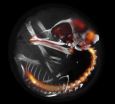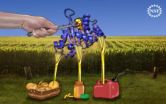(Press-News.org) Research shows that street furniture, barriers, parks, public spaces and neighbourhood architecture can stir up powerful emotions in local residents. This should be taken into account in programmes designed to reduce tensions and foster community cohesion.
Four cities - Amsterdam, Beirut, Belfast and Berlin were chosen as the location of the research as each has a different social history and underlying tensions. The project was undertaken by Dr Ralf Brand of the University of Manchester and was funded by the Economic and Social Research Council (ESRC).
Dr Brand found that tensions between different social groups (ethnic, religious or political in nature) and radicalisation can have a significant impact on the urban landscape, and vice versa. This does not mean that urban environments cause, or prevent, these political positions. But some architectural and urban design features were identified that at least played a part in raising community tensions as well as those that reduced divisions.
Radicalisation of different groups in cities is usually viewed as a political issue, as well as one of community cohesion and the circumstances of the people in the community, such as the level of deprivation. "It's essential to take these factors into account, but good urban design and architecture should not be overlooked," says Dr Brand. "A better built environment will not in itself make problems disappear, but it should be part of community action plans."
Dr Brand operated with the assumption that finding ways to bring people together has the potential to reduce problems and tensions, but he gives a warning, "Any attempt to lure people to artificially created shared spaces is ethically problematic and risky because they can alienate certain groups. It's important that both social and material changes should go hand in hand in urban communities."
A great deal of effort has been made to 'harden' access to potential targets of attack. For example, bollards are often installed to protect vulnerable facilities. Recently, urban designers have been trying to hide such measures to make them less visible. However, Dr Brand suggests that, while it is good to tone down protective barriers, they can still create a disturbing atmosphere.
He explains, "it's not just about taking measures to prevent bad things from happening in our cities, we need to foster good things too: bring people together; break down stereotypes and tackle segregation."
During the project, Dr Brand noted that in an effort to bring local residents on to the streets, authorities in Amsterdam installed a large chessboard in a public square. People were attracted to the area and playing chess in public has helped create a positive atmosphere.
"I'm not saying giant chessboards everywhere are the solution for reducing tensions in communities, but they illustrate the type of initiative we should be thinking about."
Findings from the research are helping policymakers, planners, architects, urban designers and ordinary citizens create urban areas that contribute to the friendly encounter of different groups of people. Dr Brand believes this will help tackle stereotypes, polarisation and radicalisation in communities.
INFORMATION:
For further information contact
Dr Ralf Brand
Email: ralf.brand@manchester.ac.uk
Telephone: 0161 275 0317
ESRC Press Office:
Danielle Moore-Chick
Email: danielle.moore-chick@esrc.ac.uk
Telephone 01793 413122
Jeanine Woolley
Email: jeanine.woolley@esrc.ac.uk
Telephone 01793 413119
Notes for editors:
1. This release is based on findings from the research project: ''The urban environment: Mirror and mediator of radicalisation?' and was carried out by Dr Ralf Brand and co-investigator Dr Jon Coaffee, with research assistant Dr Sara Fregonese at the University of Manchester. The project was part of "New Security Challenges: 'Radicalisation' and Violence - A Critical Reassessment", co-funded by the Economic and Social Research Council, the Arts and Humanities Research Council and the Foreign and Commonwealth Office. A book based on the project is due for release in June 2012.
2. The project took place between 2007 and 2009. It involved an initial study of related literature and was followed by field work in Amsterdam, Beirut, Belfast and Berlin. This included semi-structured interviews with over 100 people and the use, by volunteers, of disposable cameras to document urban environments. Findings have been disseminated widely. This has included briefings, articles and a travelling project exhibition that visited the cities involved, plus several other venues. The exhibition is still available for display for free.
3. The Economic and Social Research Council (ESRC) is the UK's largest organisation for funding research on economic and social issues. It supports independent, high quality research which has an impact on business, the public sector and the third sector. The ESRC's total budget for 2011/12 is £203 million. At any one time the ESRC supports over 4,000 researchers and postgraduate students in academic institutions and independent research institutes. More at www.esrc.ac.uk
4. The ESRC confirms the quality of its funded research by evaluating research projects through a process of peers review. The research has been graded as very good
END
This is one of the principle conclusions of a study that has been published in the scientific journal Current Biology. Participants in the study included Evan Balaban (McGill University, Montreal), Manuel Desco (Gregorio Marañón General University Hospital of Madrid and UC3M) and Juan José Vaquero (UC3M). The researchers managed to arouse a chicken embryo by exposing it to a sound that would have meaning after its birth (for example, the sound of a chicken warning others of danger). However, their study has demonstrated that the animal does not have the same reaction when ...
Banning and criminalising the Muslim face veil tests the very foundations of modern liberal society, warn researchers from Queen Mary, University of London and the University of Sussex.
The paper 'Reasons to Ban? The Anti-Burqa Movement in Western Europe' examines the move to legislate against, and to criminalise face-veiling which has swept across the EU recently.
The European movement against face-veiling is now widespread, with calls to implement a ban, or a ban being in place, in France, Belgium, Italy, Spain, the Netherlands, Scandinavia, and Germany.
This move ...
Hospitals in large cities act as breeding grounds for the superbug MRSA prior to it spreading to smaller hospitals, a study suggests.
Researchers found evidence that shows for the first time how the superbug spreads between different hospitals throughout the country.
The University of Edinburgh study involved looking at the genetic make-up of more than 80 variants of a major clone of MRSA found in hospitals.
Scientists were able to determine the entire genetic code of MRSA bacteria taken from infected patients.
They then identified mutations in the bug which led ...
About 45 real-world senior engineering projects from the University of Cincinnati's College of Engineering and will go on display from noon-3 p.m., on Wednesday, May 16, in UC's Tangeman University Center. The projects represent work by seniors in electrical engineering, electrical engineering technology, computer engineering, computer engineering technology and computer science.
Below is a sampling of the projects you will see
TWIPOLITICO
Seniors Jorge Moscat Pardos, Chris Nixon and Opeyemi Oyediran created a site and application, titled "Twipolitico," that analyzes ...
ANN ARBOR, Mich. – In an era of tight funding, school districts across the country are cutting their athletic budgets. Many schools are implementing athletic participation fees to cover the cost of school sports. But those fees have forced kids in lower-income families to the sidelines, according to a new poll that found nearly one in five lower-income parents report their children are participating less in school sports.
The University of Michigan C.S. Mott Children's Hospital National Poll on Children's Health recently asked parents of middle- and high-school-age children ...
A number of studies have shown that it is possible to lengthen the average life of individuals of many species, including mammals, by acting on specific genes. To date, however, this has meant altering the animals' genes permanently from the embryonic stage – an approach impracticable in humans. Researchers at the Spanish National Cancer Research Centre (CNIO), led by its director María Blasco, have proved that mouse lifespan can be extended by the application in adult life of a single treatment acting directly on the animal's genes. And they have done so using gene therapy, ...
Research from North Carolina State University will allow the development of energy-efficient LED devices that use ultraviolet (UV) light to kill pathogens such as bacteria and viruses. The technology has a wide array of applications ranging from drinking-water treatment to sterilizing surgical tools.
"UV treatment utilizing LEDs would be more cost-effective, energy efficient and longer lasting," says Dr. Ramón Collazo, an assistant professor of materials science and engineering at NC State and lead author of a paper describing the research. "Our work would also allow ...
Functional sportswear is taken for granted nowadays. It is quite unexceptional for a sports jacket, for instance, to be both waterproof and breathable. In the case of working clothes, the functionality is mostly restricted to personal protection against fire, sharp objects, chemicals and so on, with wearer comfort (mostly) not being significance top priority. Bullet-proof vests made of Kevlar, as their name suggests, hold off bullets but they are also impenetrable for water vapor. Thus police personnel who must wear such gear under their uniforms sweat profusely when the ...
A curious twist in a family of plant proteins called chalcone-isomerase recently was discovered by Salk Institute for Biological Studies scientist Joseph Noel and colleagues at Iowa State University led by Eve Wurtele.
Pursuing basic scientific discovery, they found three similar proteins that could soon translate into positive results for bio-renewable fuels, commodity chemicals like plastics, food security and nutrition and biomedicine.
The findings, reported May 13 in advance online publication of the journal Nature, may lead to higher-yield crops and quantities of ...
Philadelphia, PA, May 14, 2012 – Health professionals commonly say, "Don't look and it won't hurt" before administering an injection, but is there any scientific basis for the advice? A group of German investigators has found that, in fact, your past experience with needle pricks, along with information you receive before an injection, shape your pain experience. Their research is published in the May issue of Pain®.
"Throughout our lives, we repeatedly experience that needles cause pain when pricking our skin, but situational expectations, like information given by ...


